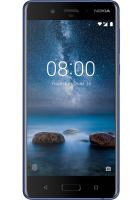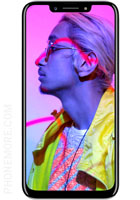Nokia 8 (128GB) vs Blu Vivo One Plus (2019)
Side by side comparison between Nokia 8 vs Blu Vivo One Plus (2019) phones, differences, pros, cons and full specifications. What's the better?
,
5.3"
IPS
IPS
1440x2560
13
MP
MP
13mp
6GB
RAM
RAM
Octa-core
3090
mAh
mAh
(Non removable)
vs
6.2"
IPS
IPS
720x1520
13
MP
MP
8mp
2GB
RAM
RAM
Quad-core
3000
mAh
mAh
(Non removable)
What's the better phone? Nokia 8 (128GB)
The phonemore's choice is much more technical than personal. Therefore, you shouldn't only consider this. Our goal is to help you, but what's important to us may not be important to you. You decide which one is the best! Comment!
| 17 Common items in both devices |
| TFT IPS LCD |
| 16 million |
| Only digital zoom |
| PDAF: phase detection autofocus on both cameras / Autofocus |
| HDR photo on both cameras |
| 4G LTE-A / 4G LTE |
| Capacitive |
| +10 specs and more in the table below |
Check the comparison table below for more items that are not evaluated in comparison score above.
Highlight differences Clear highlight📱 Model features | ||
| Nokia 8 (128GB) | Blu Vivo One Plus (2019) | |
| Model | Nokia 8 (128GB) | Vivo One Plus (2019) |
| Other model names | Nokia 8 (6GB RAM) | BLU Vivo One Plus 2019 VP370WW |
| Country or region available |  (Global, International) |   USA, (Global, International) |
| Brand | Nokia | Blu |
| Release date | 9/1/2017 | 1/1/2019 |
| Depth | 7.9 millimeters (0.31 inches) | 8.3 millimeters (0.33 inches) |
| Size (width x height) | 73.7 x 151.5 millimeters (2.9 x 5.96 in) | 75.2 x 156.7 millimeters (2.96 x 6.17 in) |
| Weight | 160 grams (5.6 ounces) | 178 grams (6.23 ounces) |
| Build, materials | Aluminum body, glass front | Plastic body, glass front |
| Protection against water and others | IP54 certified: protection against dust and splashing | Not supported |
📲 Display | ||
| Nokia 8 (128GB) | Blu Vivo One Plus (2019) | |
| Display type | TFT IPS LCD | TFT IPS LCD |
| Screen size | 5.3" inches | 6.2" inches |
| Screen-to-body ratio | ~69.4% (screen-to-body ratio) | ~81.4% (screen-to-body ratio) |
| Display resolution | 1440x2560 pixels | 720x1520 pixels |
| Touchscreen | Capacitive Multitouch | Capacitive Multitouch |
| Pixel density (dot pitch) | 554 PPI | 271 PPI |
| Colors | 16 million | 16 million |
| Scratch-resistant glass | Gorilla Glass 5 | Not supported |
| Refresh rate | feature not registered | feature not registered |
| Display features | feature not registered | feature not registered |
🤖 Operating System | ||
| Nokia 8 (128GB) | Blu Vivo One Plus (2019) | |
| System version | Android 7.1.1 Nougat | Android 8.1 Oreo |
| Firmware update | Android 9.0 Pie | feature not registered |
| User Interface | feature not registered | feature not registered |
⚙️ Processor | ||
| Nokia 8 (128GB) | Blu Vivo One Plus (2019) | |
| Chipset | 64bit: Qualcomm Snapdragon 835 (MSM8998) (10nm) | 64bit: MediaTek MT6739 (28nm) |
| CPU | Octa-core, 2 processors: 4x 2.45GHz Kryo 280 (Quad-core) 4x 1.9GHz Kryo 280 (Quad-core) | Quad-core, 1 processor: 4x 1.5GHz ARM Cortex-A53 (Quad-core) |
| GPU graphical controller | Qualcomm Adreno 540 (670-710MHz) | PowerVR GE8100 MP1 (570MHz) |
| Performance (benchmark) | feature not registered | feature not registered |
💽 Memory and storage | ||
| Nokia 8 (128GB) | Blu Vivo One Plus (2019) | |
| RAM memory | 6GB LPDDR4X | 2GB LPDDR3 |
| Internal storage | 128GB (114GB available) UFS 2.1 | 16GB (12GB available) eMMC 5.1 |
| External storage | Until 256GB microSD, microSDXC (hybrid slot/shares the same SIM-2 slot) | Until 64GB microSD, microSDXC (dedicated slot) |
📶 Mobile networks | ||
| Nokia 8 (128GB) | Blu Vivo One Plus (2019) | |
| Dual-SIM | Dual-SIM Standby - Call active on one sim card (hybrid slot/shares the same microSD slot) | Dual-SIM Standby - Call active on one sim card (dedicated slot) |
| SIM card | 2 slots (Dual-SIM) nano-SIM (4FF) | 2 slots (Dual-SIM) nano-SIM (4FF) |
| Maximum Download / Upload | 450/50 Mbps | 150/50 Mbps |
| Network technology | 2G, 3G, 4G | 2G, 3G, 4G |
| Frequency, bands | Expand band details Collapse details | |
| GSM MHz band | Quad-Band 850/900/1800/1900 | Quad-Band 850/900/1800/1900 |
| Primary 2G network | CDMA 800, GSM 850/900/1800/1900 | GSM 850/900/1800/1900 |
| Primary 3G network | CDMA2000 EV-DO TD-SCDMA 1900/2000 UMTS 850/900/1900/2100 | UMTS 850/900/1700/1900/2100 |
| Primary 4G network | LTE Cat9 (Bands 1, 2, 3, 4, 5, 7, 8, 20, 28) TD-LTE (Bands 38, 39, 40, 41) | LTE Cat4 (Bands 1, 2, 3, 4, 5, 7, 12, 17, 28) |
| Primary 5G network | Not supported | Not supported |
| Primary data network | GPRS, EDGE, CDMA2000 EV-DO Rev 0, CDMA2000 EV-DO Rev A, TD-SCDMA, UMTS, HSDPA, HSUPA, HSPA+, TD-LTE, LTE, LTE-A | GPRS, EDGE, UMTS, HSDPA, HSUPA, HSPA+, LTE |
| Secondary 2G network | GSM 850/900/1800/1900 | GSM 850/900/1800/1900 |
| Secondary 3G network | Not supported | Not supported |
| Secondary 4G network | Not supported | Not supported |
| Secondary data network | GPRS, EDGE | GPRS, EDGE |
📷 Camera | ||
| Nokia 8 (128GB) | Blu Vivo One Plus (2019) | |
| Back camera (main camera) | (dual camera) 13 megapixels 13MP mono f/2.01.12µmPDAFLaserAF | (dual camera) 13 megapixels 2MP depth |
| Main camera resolution | 4128x3096 pixels | 4128x3096 pixels |
| Video recording (primary) | 4K UHD (3840x2160) 30 fps | Full HD (1920x1080) 30 fps |
| Flash | Dual-LED flash | LED flash on both cameras |
| Focal aperture | f/2.0 (aperture) | f/2.2 (aperture) |
| Focal length | feature not registered | feature not registered |
| Sensor size | feature not registered | 1/4" inches |
| Pixel size | 1.12µm pixel | feature not registered |
| Autofocus | PDAF: phase detection autofocus on both cameras | Autofocus |
| Touch focus | Supported | Supported |
| Image stabilization | OIS: Optical stabilization | EIS: Digital stabilization |
| Zoom | Only digital zoom | Only digital zoom |
| Face/smile detection | Face detection, Smile detection | Face detection, Smile detection |
| BSI sensor | Not supported | Not supported |
| HDR | HDR photo on both cameras | HDR photo on both cameras |
| Camera extras | feature not registered | feature not registered |
📸 Front camera | ||
| Nokia 8 (128GB) | Blu Vivo One Plus (2019) | |
| Front camera (secondary) | 13 megapixels | 8 megapixels |
| Front camera resolution | 4128x3096 pixels | 3264x2448 pixels |
| Video recording (secondary) | 4K UHD (3840x2160) | Full HD (1920x1080) |
| Front flash | Not supported | LED |
| Focal aperture | f/2.0 (aperture) | f/2.2 (aperture) |
| Focal length | feature not registered | feature not registered |
| Sensor size | feature not registered | 1/5" inches |
| Pixel size | 1.12µm pixel | feature not registered |
🔉 Sound and multimedia | ||
| Nokia 8 (128GB) | Blu Vivo One Plus (2019) | |
| Loudspeaker | Supported | Supported |
| Active noise cancellation | 2 microphones or more | Not supported |
| Radio | FM | FM |
| TV | Not supported | Not supported |
| Video formats | MP4, H.265, H.264, H.263 | MP4, H.264, H.263, XviD, MKV |
| Audio formats | MP3, OGG, eAAC+, FLAC | MP3, WAV, WMA, eAAC+, FLAC |
🔌 Connectivity | ||
| Nokia 8 (128GB) | Blu Vivo One Plus (2019) | |
| USB | USB 3.1 Type-C reversible connector | MicroUSB 2.0 |
| Audio output | 3.5mm jack | 3.5mm jack |
| TV output | Not supported | Not supported |
| Bluetooth | 5.0 + A2DP/LE | 4.0 + A2DP |
| WiFi | 802.11 a/b/g/n/ac [wifi5] (2.4GHz, 5GHz) + MIMO WiFi Direct, hotspot | 802.11 b/g/n [wifi4] (2.4GHz) WiFi Direct, hotspot |
| DLNA | Not supported | Not supported |
| GPS | A-GPS, GeoTagging, GLONASS, BeiDou | A-GPS, GeoTagging |
| NFC | Supported | Not supported |
| Infrared port | Not supported | Not supported |
🧭 Sensors | ||
| Nokia 8 (128GB) | Blu Vivo One Plus (2019) | |
| Sensors | Accelerometer Ambient light sensor Compass Fingerprint sensor Gyroscope Heart rate Proximity sensor | Accelerometer Ambient light sensor Fingerprint sensor (rear-mounted) Proximity sensor |
| Vibrating alert | Supported | Supported |
🔋 Battery | ||
| Nokia 8 (128GB) | Blu Vivo One Plus (2019) | |
| Battery type | LiPo: li-ion polymer (Non removable) | LiPo: li-ion polymer (Non removable) |
| Battery capacity | 3090 mAh | 3000 mAh |
| Charger, watts | 18W Wired fast charging | Wired charging |
| Inductive / wireless charging | feature not registered | feature not registered |
| Talk time autonomy | feature not registered | 16 hours |
| Standby | feature not registered | 550 hours (22.9 days) |
➕ Other features | ||
| Nokia 8 (128GB) | Blu Vivo One Plus (2019) | |
| Call control | Voice dialing, Voice recorder, Voice commands | Voice dialing, Voice recorder |
| Messaging | SMS (T9), MMS, E-mail, Push mail | SMS (T9), MMS, E-mail, Push mail |
| Hands-free calling | Supported | Supported |
| Video calling | Supported | Supported |
| Ringtones | Polyphonic and customized | Polyphonic and customized |
| Web browser | HTML, XHTML, HTML5 | HTML, XHTML, HTML5 |
| Antenna | Internal antenna | Internal antenna |
| Qwerty physical keyboard | Not supported | Not supported |
| Miscellaneous | • Colors: Blue, Polished Blue, Steel, Polished Copper • 2.5D glass screen • Carl Zeiss camera optics • Quick Charge 3.0 • Nokia OZO audio • 24-bit/192kHz audio • ANT+ support | • Colors: Silver • 19:9 display ratio • 450nit brightness display • Screen protector included • Silicone Case included |
☢️ Radiation rate | ||
| Nokia 8 (128GB) | Blu Vivo One Plus (2019) | |
| SAR 1.6W/kg (USA, Mexico, etc.) | feature not registered | feature not registered |
| SAR 2W/kg (Europe, UK, etc.) | feature not registered | feature not registered |


 29 Advantages
29 Advantages  3 Advantages
3 Advantages